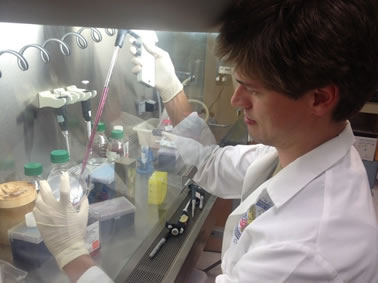Antoine de Morrée, a postdoctoral scholar at Palo Alto Veterans Institute for Research and Stanford University in Palo Alto, Calif., is testing a way to stop muscles from making toxic DUX4 protein as a possible treatment forfacioscapulohumeral muscular dystrophy (FSHD). The goals of de Morrée’s work are to understand how cells make stabile RNA messages, and to develop a way to destabilize RNA messages that allow cellular machinery to produce the DUX4 protein. These studies have the potential to lead to new treatments that will reduce the toxicity in the muscles of patients with FSHD.
Please describe your current research.
 FSHD is a muscle disease for which no treatment exists. The disease is caused when muscle cells inadvertently make a toxic protein, called DUX4. The project I’m working on will test a way to stop muscles from making the toxic protein, as a possible treatment for FSHD.
FSHD is a muscle disease for which no treatment exists. The disease is caused when muscle cells inadvertently make a toxic protein, called DUX4. The project I’m working on will test a way to stop muscles from making the toxic protein, as a possible treatment for FSHD.
It takes several steps for cells to make a protein from the information in the DNA. In theory, at each step there is a possibility to intervene. One essential step is for cells to mail the information from the DNA to the protein factories. This is done by the cell’s text messaging system, called RNA messaging. Healthy muscles do not make DUX4 protein, because they do not send stabile RNA messages to the protein factories. In FSHD muscles the RNA messages are stabilized and do reach the protein factories to make the DUX4 protein. Therefore, intercepting or breaking down such RNA messages would be a potential treatment for FSHD.
The goals of my research are to understand how cells make stabile RNA messages, and to develop a way to destabilize RNA messages for DUX4. These studies have the potential to lead to new treatments that will reduce the toxicity in the muscles of patients with FSHD.
What inspired you to study FSHD?
The best way to solve biomedical problems is through basic research. My background is in genetics of muscle diseases. A basic research discovery of a new mechanism of gene regulation led me to ask whether it could be used to shut down genes in a therapeutic way in muscle diseases. The toxic protein DUX4 in FSHD is a great target.

Why is your area of focus important?
Cells are pretty good at regulating genes and proteins. But sometimes things do go wrong, as in the case for DUX4. I am looking for ways to help the cells respond to their mistake. We know that FSHD muscles have too much RNA message to make the DUX4 protein. What we do not understand, is how cells regulate the amount of RNA message in general. When we understand how cells regulate the stability of RNA messages, we can use this regulatory system to remove the DUX4 RNA messages. This is a unique approach to reduce the amount of DUX4 in FSHD muscles.
Does your work have any potential implications for other disease fields?
If the approach to stop the muscles from making DUX4 works, it can in theory be used to stop cells from making other proteins as well. One application might be to stop tumor proteins as a treatment of certain cancers.
What do you feel people impacted by FSHD can have the most hope about with respect to research right now?
For years, nobody knew the cause of FSHD and scientists had no clue how to pursue treatment. The identification of DUX4 offered a therapeutic target. Now, scientists around the world are working on this problem and there is hope that their combined creativity will yield a treatment.
Why is it important that MDA continue to fund research in FSHD?
Treating diseases like FSHD requires both an understanding of what goes wrong and translation of that understanding into treatments. MDA plays an instrumental role in helping to understand what happens in healthy muscles that goes wrong in FSHD and in helping to use that information to develop treatments.
To learn more about how MDA research is accelerating treatments and cures for FSHD, please visit mda.org.
